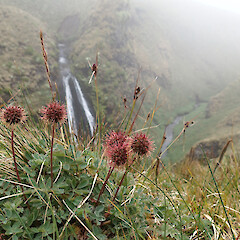Acaena magellanica
Common name
bidibid, piripiri
Family
Rosaceae
Flora category
Vascular – Native
Endemic taxon
Yes
Endemic genus
No
Endemic family
No
Structural class
Herbs - Dicotyledons other than Composites
Chromosome number
2n = 42
Current conservation status
The conservation status of all known New Zealand vascular plant taxa at the rank of species and below were reassessed in 2017 using the New Zealand Threat Classification System (NZTCS) – more information about this can be found on the NZTCS website. This report includes a statistical summary and brief notes on changes since 2012 and replaces all previous NZTCS lists for vascular plants.
Please note, threat classifications are often suggested by authors when publications fall between NZTCS assessment periods – an interim threat classification status has not been assessed by the NZTCS panel.
- Conservation status of New Zealand indigenous vascular plants, 2017 . 2018. Peter J. de Lange, Jeremy R. Rolfe, John W. Barkla, Shannel P. Courtney, Paul D. Champion, Leon R. Perrie, Sarah M. Beadel, Kerry A. Ford, Ilse Breitwieser, Ines Schönberger, Rowan Hindmarsh-Walls, Peter B. Heenan and Kate Ladley. Department of Conservation. Source: NZTCS and licensed by DOC for reuse under the Creative Commons Attribution 4.0 International licence.
2017 | Not Evaluated
Previous conservation statuses
2012 | Not Evaluated
2009 | Not Threatened
2004 | Not Threatened
Flower colours
Red/Pink
Life cycle
Spiny hypanthia are dispersed by attaching to fur, feathers and clothing and possibly also dispersed by wind and granivory (Thorsen et al., 2009)
Threats
This is a Macquarie Island endemic and occurs in the New Zealand Botanical Region but it is not encompassed by the New Zealand threat classification process as Macquarie is under the management of Australia.
Cats, rats, mice and rabbits introduced by sealers in the early 1800s posed a significant threat to sepcies endemic to Maquarie Island an when cats were initially erdaticated nearly a century later there was an explosion rabbits numbers. Further efforts were made to remove rodent perst by the Australian Government and in 2014 Macqurie was declared pest free.
Etymology
acaena: From the Greek ‘akanthos’ thorn, referring to the spiny calyx that many species have
magellanica: Named after the Magellan Straits in southern South America
References and further reading
Thorsen, M. J.; Dickinson, K. J. M.; Seddon, P. J. 2009. Seed dispersal systems in the New Zealand flora. Perspectives in Plant Ecology, Evolution and Systematics 2009 Vol. 11 No. 4 pp. 285-309









